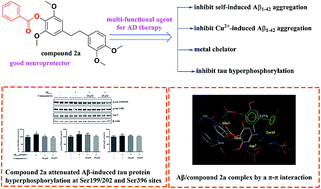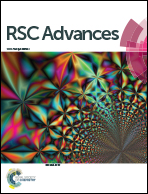Synthesis and evaluation of neuroprotective 4-O-substituted chrysotoxine derivatives as potential multifunctional agents for the treatment of Alzheimer's disease†
Abstract
A series of 4-O-substituted chrysotoxine (CTX) derivatives were designed, synthesized and evaluated as multifunctional agents for the treatment of Alzheimer's disease (AD). In vitro assays indicated that four ring substituted compounds (2a, 2b, 3i and 3j) exhibited significant neuroprotective effects against Aβ25–35-induced toxicity in PC12 cells. The four compounds also inhibited self- and Cu2+-induced Aβ1–42 aggregation and acted as biometal chelators. In particular, compound 2a was a potential lead compound for AD treatment (cell viability up to 100.78% at 50 µM in Aβ25–35-treated PC12 cells, 51.88% and 58.03% inhibition at 25 µM for self- and Cu2+-induced Aβ1–42 aggregation, respectively). A metal chelating experiment showed that compound 2a had a moderate interaction with Cu2+ and Al3+. Moreover, western blot analysis showed that compound 2a attenuated Aβ-induced tau protein hyperphosphorylation at Ser199/202 and Ser396 sites. Furthermore, compound 2a could efficiently cross the blood-brain barrier (BBB) by a parallel artificial membrane permeability assay (PAMPA). In summary, these results suggested that compound 2a was a promising multifunctional compound for AD therapy.

- This article is part of the themed collection: Towards understanding and treating Alzheimer’s disease

 Please wait while we load your content...
Please wait while we load your content...